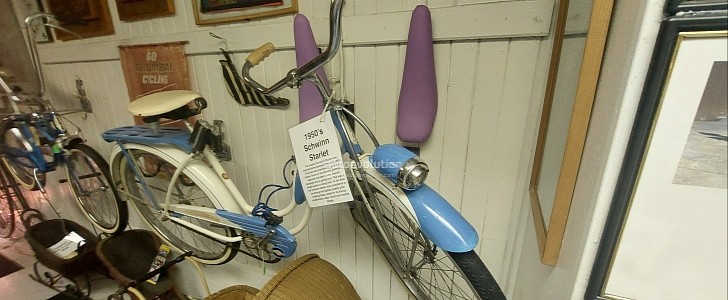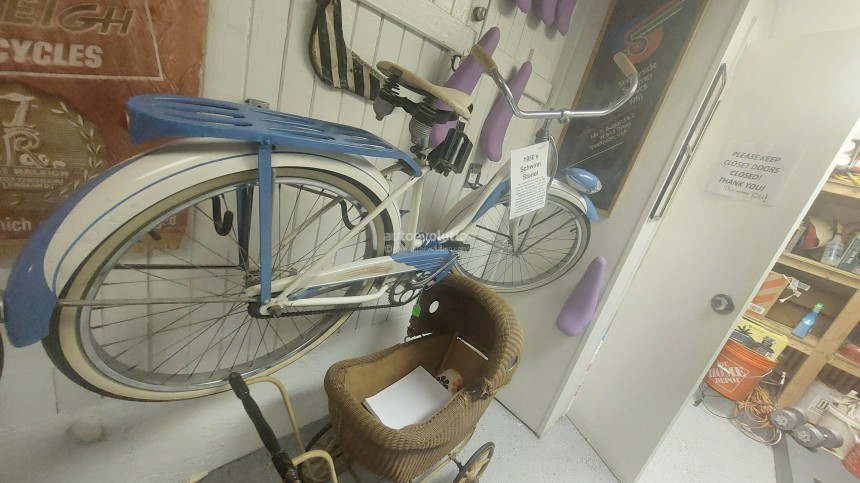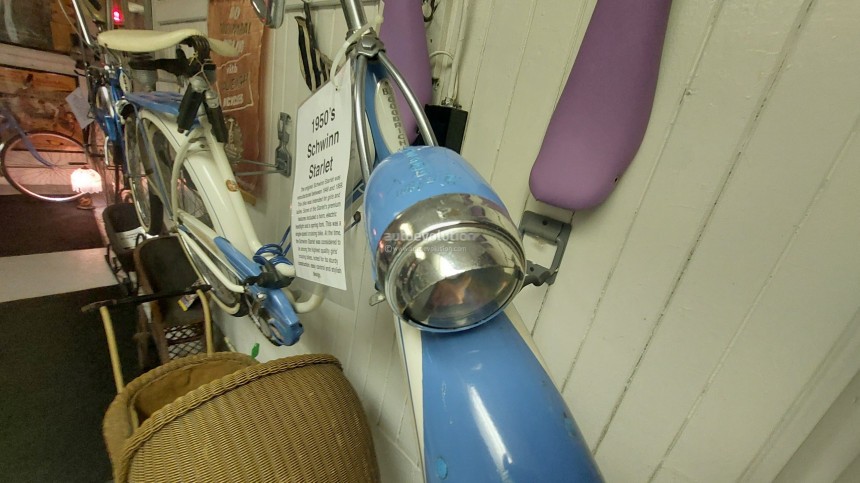The world's greatest museums all have one thing in common. They're all completely stuffed to the gills with wonderful exhibits. Some museums, like the U.S. Air Force Museum, need a complex hundreds of acres wide to accommodate everything. But even it doesn't have super rare artifacts hanging from the bathroom.
But that's something the Bicycle Heaven Museum in Pittsburgh, Pennsylvania, can brag about. In a lot of ways, this privately owned collection of upwards of 5,000 bicycles is a bit like the Air Force Museum of bicycles. The definitive largest collection of its kind anywhere in the world. In this museum, there's cool stuff hanging from the walls right across from the old porcelain throne.
But as far as eye candy goes, as you peek over the bathroom stall in the middle of your "business," this ultra-rare and beautifully preserved Schwinn Starlet sure beats a cheap office painting. If you could believe it or not, this bike used to be more or less the Cadillac of American bicycles for women. A single-speed cruiser with no need for anything more. Further still, this was one of the very first post-war cruiser bikes built for women.
This market objective slanted towards women and girls was evident in every aspect of Starlet's marketing, engineering, and design language. With paint color selections available in names like Holiday Rose, Summer Cloud White, Windswept Green, and Luscious Lavender, it goes to show just how on the nose lots of old advertisements used to be. Safe to say, gender norms have advanced a fair bit since the 1950s, mercifully.
Standard equipment included an electroplated forged steel frame, fully streamlined and manufactured at Schwinn's primary factory in Chicago. Along with a crankset drop forged from high carbon steel, triple heat treated cups, and cones with chromed ball bearings. The kickstand was of Schwinn's design as well. Consisting of a brand new at the time design with a patented rattle and dustproof construction.
The tires on this bike were manufactured in-house by Schwinn and come from their Typhoon line of cruiser bike tires measuring 26 x 2 1/8" front and rear. At the same time, rims were chrome plated and came from the Schwinn S2 line of tubular wheels. In good condition, these wheels and tires would be worth a fair bit of money all on their own, perhaps $300 to $400 for the set in modern times. There was even a soft touch streamlined carrier bag available, attached directly to the frame, which this model doesn't seem to have.
The front hubs sport removable bearing cups, which are quite practical for maintenance purposes, and the solid metal chain guard was embossed with a stylized "Starlet" logo on the right-hand side. It's the most surefire way to easily identify it as a rare and unique model. The handlebars were painted in chrome, as was the sibling bike to the Starlet model, called the Boy Scout Edition, but based on the very same architecture as the Starlet.
With a total shipping weight of just over 60 pounds, the Starlet was clearly aimed at, so to say, older than the adolescent age bracket. Sturdy and stable at high speeds but also supremely controllable in low-speed cruising. It's a trademark of Schwinn Bicycles of the period, which saw the brand rise to become the number one American bicycle manufacturer. Sadly, most of their models these days are made in China.
So many aspects of the design language scream the 1950s in a way other bikes from this era don't. From the shrowded, chrome-plated front headlamp dubbed "the Rocket Ray" by Schwinn's own advertising to the factory embossed Starlett emblem proudly displaying itself every time a guest in this free to enter museum decides it's time to do their business.
You might find it odd or strange that Craig Morrow, the owner, and curator of Pittsburgh's Bicycle Heaven Museum, decided to hang rare and valuable bicycles from the walls of his museum's bathroom. Rest assured, people who get to meet him in person usually say he has a pretty wacky sense of humor. He understands the lunacy behind his collection of over 6,000 rare and classic bikes and decided to double down on things. For this noblest of causes, we thank you, Craig.
Check back for more from our trip to the Pittsburgh Bicycle Heaven here on autoevolution.
But as far as eye candy goes, as you peek over the bathroom stall in the middle of your "business," this ultra-rare and beautifully preserved Schwinn Starlet sure beats a cheap office painting. If you could believe it or not, this bike used to be more or less the Cadillac of American bicycles for women. A single-speed cruiser with no need for anything more. Further still, this was one of the very first post-war cruiser bikes built for women.
This market objective slanted towards women and girls was evident in every aspect of Starlet's marketing, engineering, and design language. With paint color selections available in names like Holiday Rose, Summer Cloud White, Windswept Green, and Luscious Lavender, it goes to show just how on the nose lots of old advertisements used to be. Safe to say, gender norms have advanced a fair bit since the 1950s, mercifully.
Standard equipment included an electroplated forged steel frame, fully streamlined and manufactured at Schwinn's primary factory in Chicago. Along with a crankset drop forged from high carbon steel, triple heat treated cups, and cones with chromed ball bearings. The kickstand was of Schwinn's design as well. Consisting of a brand new at the time design with a patented rattle and dustproof construction.
The front hubs sport removable bearing cups, which are quite practical for maintenance purposes, and the solid metal chain guard was embossed with a stylized "Starlet" logo on the right-hand side. It's the most surefire way to easily identify it as a rare and unique model. The handlebars were painted in chrome, as was the sibling bike to the Starlet model, called the Boy Scout Edition, but based on the very same architecture as the Starlet.
With a total shipping weight of just over 60 pounds, the Starlet was clearly aimed at, so to say, older than the adolescent age bracket. Sturdy and stable at high speeds but also supremely controllable in low-speed cruising. It's a trademark of Schwinn Bicycles of the period, which saw the brand rise to become the number one American bicycle manufacturer. Sadly, most of their models these days are made in China.
You might find it odd or strange that Craig Morrow, the owner, and curator of Pittsburgh's Bicycle Heaven Museum, decided to hang rare and valuable bicycles from the walls of his museum's bathroom. Rest assured, people who get to meet him in person usually say he has a pretty wacky sense of humor. He understands the lunacy behind his collection of over 6,000 rare and classic bikes and decided to double down on things. For this noblest of causes, we thank you, Craig.
Check back for more from our trip to the Pittsburgh Bicycle Heaven here on autoevolution.









